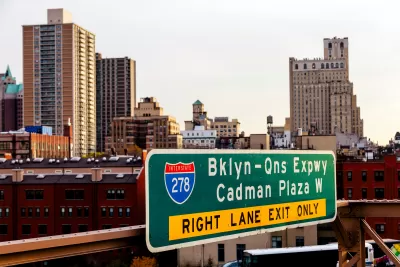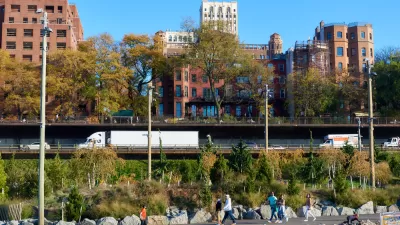The crucial freight connection is ‘crumbling,’ but a decision on how to move forward with repairing and supplementing it continues to elude the city.

Are fears of the Brooklyn-Queens Expressway’s imminent collapse unfounded? Yes and no, according to an article by Clio Chang in Curbed.
Sam Schwartz, former New York City traffic commissioner, who spoke with Chang, says “the Brooklyn-Queens Expressway is that it isn’t going to collapse in the way you think it might.” However, Chang explains that “the most distressed stretch — the triple cantilever that runs from Sands Street to Atlantic Avenue — is crumbling, which raises all kinds of other unhappy scenarios.”
Even small pieces of falling concrete could pose serious danger to people and cars below. Schwartz warns that “The most likely scenario that could cause a serious problem is a hole through the deck: in other words, a pothole that goes all the way through and a truck hits that and could lose control.”
The city has explored various plans to solve the problem, but for Schwartz, “The question is, Can they be built without disrupting the community to such an extent? Brooklyn doesn’t have any other truck-route expressways that go through it, so this is the only route from the western United States via the Verrazzano Bridge.”
According to Schwartz, “the city just needs to pick a plan and sort of go with it” before it’s too late. “I’m recommending fewer lanes and not encouraging car traffic. Congestion pricing will work, but I don’t see a way of taking this expressway out at this time.”
FULL STORY: So Is the BQE Going to Collapse?

Alabama: Trump Terminates Settlements for Black Communities Harmed By Raw Sewage
Trump deemed the landmark civil rights agreement “illegal DEI and environmental justice policy.”

Planetizen Federal Action Tracker
A weekly monitor of how Trump’s orders and actions are impacting planners and planning in America.

The 120 Year Old Tiny Home Villages That Sheltered San Francisco’s Earthquake Refugees
More than a century ago, San Francisco mobilized to house thousands of residents displaced by the 1906 earthquake. Could their strategy offer a model for the present?

In Both Crashes and Crime, Public Transportation is Far Safer than Driving
Contrary to popular assumptions, public transportation has far lower crash and crime rates than automobile travel. For safer communities, improve and encourage transit travel.

Report: Zoning Reforms Should Complement Nashville’s Ambitious Transit Plan
Without reform, restrictive zoning codes will limit the impact of the city’s planned transit expansion and could exclude some of the residents who depend on transit the most.

Judge Orders Release of Frozen IRA, IIJA Funding
The decision is a victory for environmental groups who charged that freezing funds for critical infrastructure and disaster response programs caused “real and irreparable harm” to communities.
Urban Design for Planners 1: Software Tools
This six-course series explores essential urban design concepts using open source software and equips planners with the tools they need to participate fully in the urban design process.
Planning for Universal Design
Learn the tools for implementing Universal Design in planning regulations.
Clanton & Associates, Inc.
Jessamine County Fiscal Court
Institute for Housing and Urban Development Studies (IHS)
City of Grandview
Harvard GSD Executive Education
Toledo-Lucas County Plan Commissions
Salt Lake City
NYU Wagner Graduate School of Public Service




























